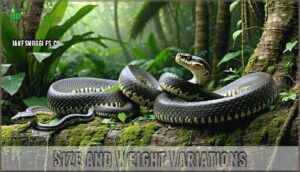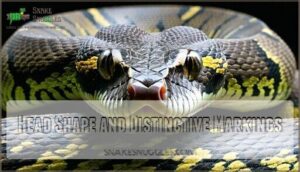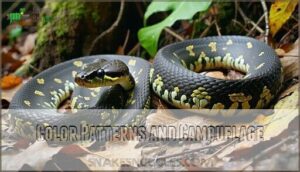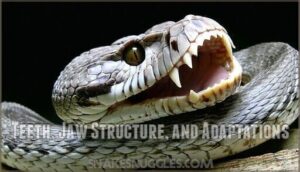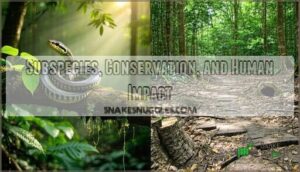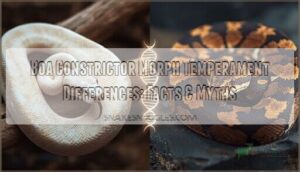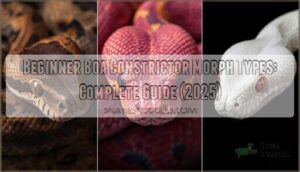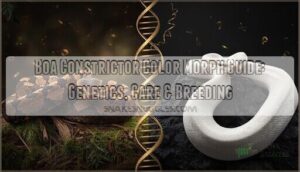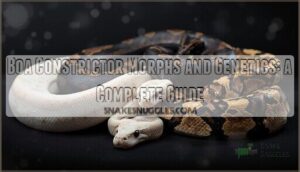This site is supported by our readers. We may earn a commission, at no cost to you, if you purchase through links.
 Deep within tangled rainforests and along the sunbaked edges of rivers, the boa constrictor quietly shapes entire ecosystems. With muscle-packed coils and intricate saddle markings painted across its back, this species slips between shadows, unseen yet ever-present.
Deep within tangled rainforests and along the sunbaked edges of rivers, the boa constrictor quietly shapes entire ecosystems. With muscle-packed coils and intricate saddle markings painted across its back, this species slips between shadows, unseen yet ever-present.
Its presence goes well beyond myth—a living relic whose subtle power commands respect from both scientists and storytellers. Whether you’re enchanted by their social intelligence or curious about what gives these snakes their advantage, a boa constrictor species profile reveals more than raw statistics.
Understanding these noteworthy reptiles opens a window to the wild, where survival depends on adaptation.
Table Of Contents
- Key Takeaways
- Boa Constrictor Species Overview
- Physical Characteristics and Identification
- Habitat and Geographic Distribution
- Behavior, Diet, and Reproduction
- Subspecies, Conservation, and Human Impact
- Frequently Asked Questions (FAQs)
- What is the profile of a boa constrictor?
- How many different types of boa constrictors are there?
- Which is bigger BCC or BCI?
- Are boas aggressive to humans?
- What is the friendliest species of boa?
- What family is the boa constrictor in?
- What is the average lifespan of pet boas?
- How do boa constrictors thermoregulate in the wild?
- Are boa constrictors susceptible to any specific diseases?
- What unique behaviors do boas show in captivity?
- Conclusion
Key Takeaways
- Boa constrictors are powerful, adaptable snakes that play a critical role in balancing ecosystems by controlling prey populations and maintaining biodiversity.
- Their physical features—like heat-sensing pits, strong jaws, and camouflage patterns—let them thrive in diverse habitats from rainforests to savannas.
- These snakes reproduce by giving birth to live young, and with proper care, captive boas can live over 25 years.
- Human activities, including habitat loss, the pet trade, and invasive populations, challenge their survival, making conservation and responsible ownership essential.
Boa Constrictor Species Overview
The boa constrictor stands as one of the most recognizable snakes in the Americas, blending power with precision in a package that’s captivated scientists and enthusiasts for generations.
Understanding where this species fits in the natural world—and why it matters—starts with the basics of its classification and ecological role. Let’s break down the fundamentals of what makes a boa constrictor a boa constrictor.
Taxonomy and Classification
If you’re trying to make sense of where boa constrictors fit in the snake family tree, you’ll want to start with their scientific classification—it’s less tangled than you might think. The boa constrictor belongs to the genus Boa within family Boidae.
Recent evolutionary history reveals morphological variation across its range, sparking ongoing subspecies debate. Researchers still discuss whether forms like Boa constrictor occidentalis and Boa constrictor ortonii warrant distinct status, especially given hybridization potential where populations overlap.
Common and Scientific Names
The scientific name Boa constrictor doubles as the common name, which can confuse folks new to herpetology—but it’s also a reminder that this species has been recognized and studied long enough to blur the line between Latin binomial and everyday language. Regional variations add color: you’ll hear "redtailed boa" in North America’s pet trade, while "common boa" persists across field guides.
- Etymology origins trace to Latin boa (a large water snake) and constrictor (one who binds).
- Name evolution reflects Boa imperator splitting off as a distinct species in 2009.
- Synonymy confusion arises because older literature lumped multiple Boa constrictor species together.
- Naming authorities like Linnaeus (1758) formalized the binomial system we use today.
Role in Ecosystems
Beyond those scientific labels, boa constrictors earn their keep as ecological middlemen—regulating populations of rodents, birds, and other prey animals that might otherwise overrun their habitats. When you understand their role in prey population control and nutrient cycling, you’re seeing how tropical ecosystems maintain biodiversity conservation and ecosystem health through natural checks and balances.
Their presence signals healthy ecosystem functioning—a reminder that every predator plays a part in ecosystem preservation.
| Ecological Function | Impact on Wildlife Ecology |
|---|---|
| Prey population control | Prevents rodent overpopulation in tropical ecosystems |
| Nutrient cycling | Redistributes energy through predation |
| Ecosystem preservation | Maintains animal habitat balance and biodiversity conservation |
Physical Characteristics and Identification
When you first look at a boa constrictor, you’ll notice features that make it instantly recognizable—from its powerful build to the intricate patterns running down its back. Understanding these physical traits helps you identify different boas and appreciate how they’ve adapted to survive in diverse habitats.
Let’s break down the key characteristics that define this impressive snake.
Size and Weight Variations
When you’re looking at boa constrictors, size varies dramatically—females usually stretch 7–10 feet and tip the scales at 25–33 pounds, while males stay smaller at 6–8 feet and 13–16 pounds. Sexual dimorphism runs deep in this species, with females often weighing twice as much as males. Geographic variation and subspecies size also play major roles:
- South American populations (Boa constrictor constrictor) commonly exceed 10 feet
- Central American and dwarf island subspecies reach only 3–6 feet
- Argentine boas rank among the heaviest, with females hitting 60 pounds
Captive growth often outpaces wild boa constrictor behavior due to consistent feeding, and weight factors like prey availability shape final dimensions across all boa constrictor species. These snakes are also nocturnal hunters, relying on their heat-sensing abilities to locate prey.
Head Shape and Distinctive Markings
What catches your eye first—the triangular architecture or those bold dark streaks running from each eye back toward the jaw? Head morphology in boa constrictor species showcases a long, distinctly triangular skull that’s wider than the neck. Those facial markings—dark postocular stripes extending backward—serve as reliable snake species identification markers.
Scale patterns on the crown form a unique "fingerprint," and sensory pits along the jaw detect heat signatures, shaping boa constrictor behavior during nocturnal hunts.
| Feature | Description | Function |
|---|---|---|
| Head Shape | Triangular, elongated, wider than neck | Accommodates expandable jaw structure |
| Postocular Stripes | Dark streaks from eyes to jaw | Species-specific identification markers |
| Crown Scales | Large, symmetrical plates | Protect skull; vary by subspecies |
| Labial Pits | Heat-sensing depressions along jaw scales | Detect warm-blooded prey in darkness |
| Eye Position | Lateral placement with vertical pupils | Provide binocular depth perception |
Color Patterns and Camouflage
Deep brown saddles against a gray-tan canvas—this cryptic patchwork of jagged lines, ovals, diamonds, and circles transforms every boa constrictor into a master of disguise. Pattern variations aren’t just for show:
- Match habitat coloration for predator evasion
- Camouflage effectiveness aids stealthy hunting
- Selective breeding in captivity yields unique patterns
- Snake behavior shifts with changing environments
Teeth, Jaw Structure, and Adaptations
These hooked teeth help grip prey, while jaw flexibility lets the boa swallow animals much larger than its head—no venom needed. Evolutionary adaptations in jaw structure reveal unique reptile behavior: the skull bones move independently during prey consumption.
This snake behavior is key for boa constrictor identification and uncovers how animal behavior shapes survival in ever-changing habitats.
Habitat and Geographic Distribution
Boa constrictors live in a surprising variety of places across the Americas. Their ability to settle into different environments is one reason they’re so widespread.
Here are some of the common types of spaces where you’ll find them.
Native Range in The Americas
Stretching from the steamy rainforests of northern Mexico all the way down to Argentina, boa constrictors have carved out a home in nearly every corner of the Americas.
You’ll find them thriving in both dense jungle and open savanna, weaving through island populations and adapting to shifting habitat variation.
These snakes’ biome distribution shows striking regional adaptation across their wide range overlap.
Preferred Habitats and Microenvironments
If you picture a boa constrictor curling through leafy shadows or slipping quietly into a sun-warmed hollow, you’re already catching a glimpse of how expertly these snakes pick their perfect spots to thrive.
In tropical rainforests, they use Rainforest Adaptation and Microhabitat Selection—sometimes hugging damp roots near water, sometimes choosing terrestrial burrows, or displaying Arboreal Behavior high in the trees.
Adaptations to Different Ecosystems
Ever wondered how a boa constrictor fits right in whether it’s a steamy jungle, a windswept savanna, or even a dry patch of thorn scrub? Through Climatic Adaptations, these snakes adjust everything from Camouflage Variation to Dietary Shifts.
Their Arboreal Lifestyle and Aquatic Behavior let them shift easily across Tropical Ecosystems, thriving in diverse Animal Habitats—showcasing the snake’s striking ability to adapt across Ecosystems.
Invasive Populations (e.g., Florida)
That ability to adapt extends beyond natural ranges—just look at Florida. Boa constrictors, once pets, now roam wild in Miami-Dade County, causing headaches for wildlife management. Picture these invaders in:
- tangled mangroves
- suburban gardens
- hardwood hammocks
- roadside canals
- urban neighborhoods
Control methods use eDNA detection, population modeling, and public awareness to tackle this pressing invasive species challenge; these snakes are non-native in Florida.
Behavior, Diet, and Reproduction
Understanding a boa constrictor’s daily habits, what it eats, and how it reproduces is key to its care and safety. All of these traits shape the type of space this snake needs.
Let’s look at the main options for their enclosure and what each means for your boa.
Hunting Techniques and Prey Preferences
Notice how the Boa Constrictor relies on patience—ambush strategies put it in the perfect spot to snatch unsuspecting prey. Using a rapid constriction mechanism, it immobilizes mammals, birds, or lizards.
Prey selection changes as they grow, and sometimes, group hunting surfaces. Invasive diets reveal striking adaptability, showcasing animal behavior rooted in reptile nutrition and a true carnivore’s instinct.
Activity Patterns and Shelter Use
Along with their secretive hunting style, boa constrictors spend much of their time tucked away in cool, sheltered spots, waiting for the right moment to emerge. You’ll notice their:
- Nocturnal behavior for stealth
- Shelter preferences like hollow logs or burrows
- Basking habits under filtered sun
- Seasonal activity changes
- Arboreal tendencies in dense vegetation
Such patterns are key for understanding snake habitat and animal behavior.
Viviparous Reproduction and Litter Size
This approach to animal reproduction—called viviparity—means a boa constrictor’s young arrive fully formed and ready to fend for themselves. Gestation length ranges from 100 to 120 days. Litter size varies, sometimes up to 60 neonates, depending on maternal health and breeding frequency.
Among snake species in Boidae, such clutch variation and rapid neonate independence set boas apart.
Growth, Maturity, and Lifespan
From their first breath to their full-grown years, boa constrictors move steadily through life’s stages, each one marked by its own rhythms and milestones. Growth rate is rapid in juveniles, slowing as they reach size milestones and sexual maturity, often at three to five years.
With attentive reptile care, average lifespan can surpass 25 years—boa constrictor longevity depends on genetics, environment, and consistent snake care and maintenance.
Subspecies, Conservation, and Human Impact
Before you explore which enclosure choices make sense for a boa constrictor, it helps to know about the different subspecies and their needs. Conservation status and human activity play a big part in their care and availability.
Let’s take a closer look at your main options.
Major Subspecies (BCC, BCI, Etc.)
When you look a little closer, you’ll find that Boa constrictors aren’t all the same—these snakes come in several major subspecies, each with its own unique story and subtle differences.
For vivid comparison, picture:
- BCC (Redtail Boa): vivid tails, South American roots
- BCI (Northern Boa): more muted color, Central America
- Regional morph differences
- Hybridization risks complicate Subspecies Identification
Conservation Status and Threats
Although the Boa constrictor remains listed as Least Concern on the IUCN Red List, ongoing threats like habitat loss, illegal trade, and invasive species chip away at local populations. Climate change and shrinking genetic diversity challenge their resilience.
Protecting biodiversity through reptile conservation and thoughtful wildlife conservation policies is essential if you want to keep these noteworthy species from joining the ranks of endangered species.
Role in The Pet Trade
Have you ever wondered why boa constrictors are one of the most sought-after snakes in the exotic pet world? Their calm manner and variety of morph variations make them popular as pet snakes, even for beginners. Still, ethical sourcing and captive breeding matter—responsible ownership means understanding:
- snake care and maintenance basics
- long-term commitment
- choosing reputable breeders
Exotic pet ownership isn’t a casual decision.
Conservation Efforts and Legal Protections
Winding through centuries of myth and reality, the boa constrictor today benefits from dedicated wildlife conservation and management.
Wildlife protection laws—such as CITES Appendix II—balance trade and survival, while habitat preservation, anti-poaching measures, and invasive species control protect wild populations.
Breeding programs and reintroduction initiatives also help guarantee the species’ continued role in reptile conservation efforts worldwide.
Frequently Asked Questions (FAQs)
What is the profile of a boa constrictor?
As if nature took its time perfecting a living sculpture, the boa constrictor showcases unique adaptations in Snake Anatomy, gentle temperament, and vivid colors—challenging old Boa Myths with each graceful movement through Tropical Central America’s dense, shadowy forests.
The boa constrictor glides through shadowy forests, revealing vibrant colors and gentle power shaped by millions of years of evolution
How many different types of boa constrictors are there?
There are several recognized types or subspecies, such as the Central American boa and others, often identified by regional variations and morph differences.
Hybridization potential and naming conventions add layers of complexity to Boa subspecies ID.
Which is bigger BCC or BCI?
Side by side, BCC size usually outpaces BCI size—South American BCC snakes can reach 10 feet or more, while Central American BCI boas are usually smaller.
Growth rates, captive sizes, and regional variations all shape these reptiles’ final dimensions.
Are boas aggressive to humans?
Boas rarely show aggression toward humans; their temperament is generally calm if proper snake care and training are in place.
Most Boa bites occur from stress or mishandling, so understanding animal behavior assures human safety with exotic pets.
What is the friendliest species of boa?
While no boa offers a “one-size-fits-all” answer, many pet keepers find the common boa constrictor (Boa imperator) more docile.
Boa temperament often benefits from careful captive breeding and positive interaction techniques, enhancing their suitability for reptile husbandry.
What family is the boa constrictor in?
Boa constrictors belong to the Family Taxonomy known as Boidae. This group of constrictors shares a deep evolutionary history with pythons and several tropical wildlife snakes across South America, showcasing diverse physical traits and complex snake phylogeny.
What is the average lifespan of pet boas?
Much like a well-tended garden flourishes, boa constrictors in captivity often live 20–30 years.
With proper exotic pet care, genetics, and attention to reptile health, some longevity records show pet snake ownership surpassing three decades.
How do boa constrictors thermoregulate in the wild?
You’ll see boa constrictors shift between sunlit and shaded spots to control body temperature—a classic case of basking behavior and habitat selection.
Nocturnal activity, thermal gradients, and unique physiological adaptations all tie into their survival strategy across tropical ecosystems.
Are boa constrictors susceptible to any specific diseases?
Think of a boa constrictor’s health like a woven tapestry—susceptible to snags like Infectious Diseases or Parasitic Infections.
Respiratory Illnesses and Metabolic Disorders arise without Preventative Care, underscoring exotic pet care’s importance in Reptile Health and Disease.
What unique behaviors do boas show in captivity?
In captivity, you’ll notice temperament changes, unique captive feeding habits, and social interaction shifts. Snake behavior often adapts with enclosure enrichment, while breeding behaviors and interaction experiences reveal how animal behavior and habitat shape your boa constrictor’s lifestyle.
Conclusion
What stories do the shadows of the rainforest tell when a boa constrictor slides by? This boa constrictor species profile is more than a collection of facts—it’s a reminder that resilience, silence, and subtle intelligence belong to the ancient world just beneath our feet.
You can appreciate their careful mastery—shaped by millions of years—whether you glimpse them in the wild or care for them at home. With each encounter, your understanding of their quiet dominance grows deeper.

